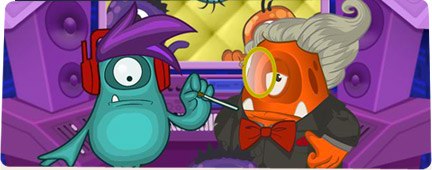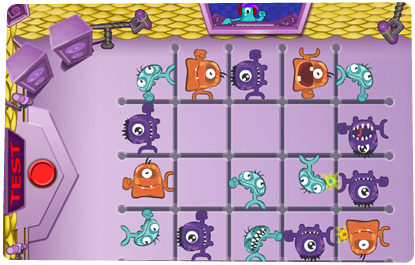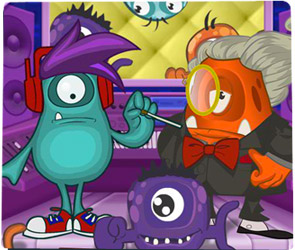Monster Music is a 20-level platformer/puzzler that addresses the misconception that electricity is a substance that flows
like water, rather than a type of energy. The game is set in Harmonia, whose odd but industrious citizens love music above all else. So when an alien
invader de-energizes the population, Harmonia’s leading musician decides to create new compositions that will combat the widespread lethargy.
As the Maestro’s apprentice, the player must get an unruly group of musicians to create beautiful music together. That requires completing puzzles in which the player aligns the hyperactive monsters in a way that causes music, rather than cacophony, to emerge. These alignment puzzles serve as an analogy for the arrangement of electrons that allows electrical energy to travel through wires. Once the music is recorded, the player races through Harmonia to deliver a disc of energizing music to the exhausted citizens. Revived, they return to their labors, a testament to the effect energy (sound, in this case) can have on matter.
The Monster Music game addresses students’ common and persistent misconception that electricity is a substance, like water that flows through a pipe. Flipping an on/off switch, then, is like turning a faucet on or off: It starts or stops the electricity from continuing to flow, but the electricity is still in the wire. The purpose of the Monster Music digital game is to help students visualize a counterintuitive scientific idea. In this case, it is to allow students to imagine electricity as a form of energy that moves through space—not like a substance, by traveling from one place to another, but by a process of alignment—creating a pattern from which a powerful form of energy emerges.
Monster Music can be used with subtopics associated with electricity: matter and energy, charge and flow, pattern and alignment, and electricity and circuits. Explanations and support materials for these are available on the Curricular Connections page.



The activities and resources provided here represent materials developed by the Possible Worlds and Analogy Mapping Study teams to help teacher-participants of the field studies integrate the digital games into their customary teaching of electricity.
The vignettes and materials presented here will help you understand how the Possible Worlds resources can be integrated with your existing approach to these topics. They are intended to help you make connections between the core mechanics of the games and the phenomena related to common scientific misconceptions.
In this activity, students become editors at NoWay!com, a website that publishes amazing-but-true stories. Two stories being considered for publication include claims about energy and electricity. Students must evaluate the validity of the claims by looking for relevant evidence in the informational resources provided. Based on what they find, they decide whether or not the site should publish the stories.
